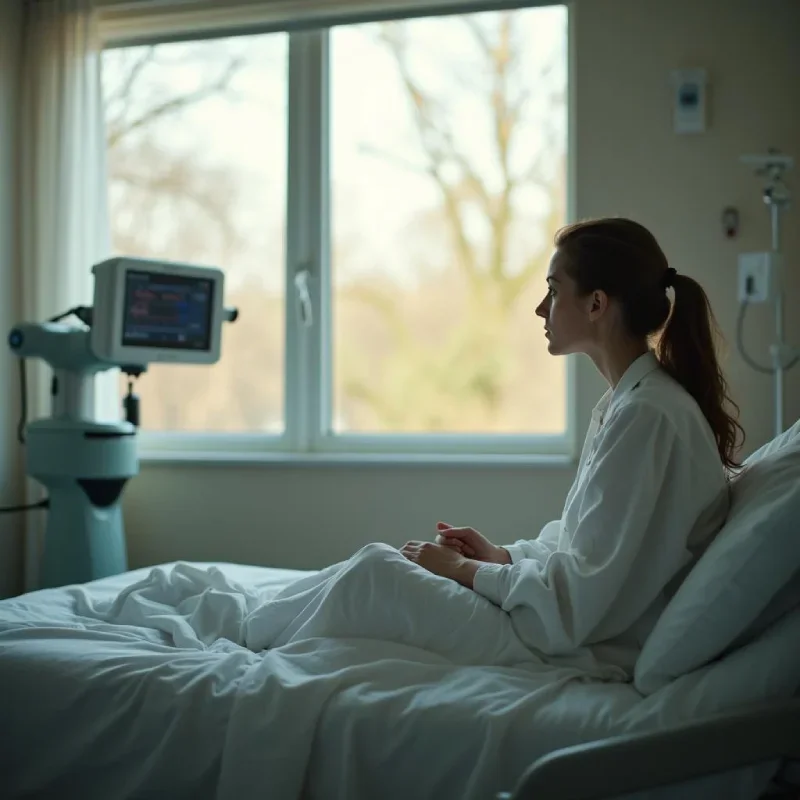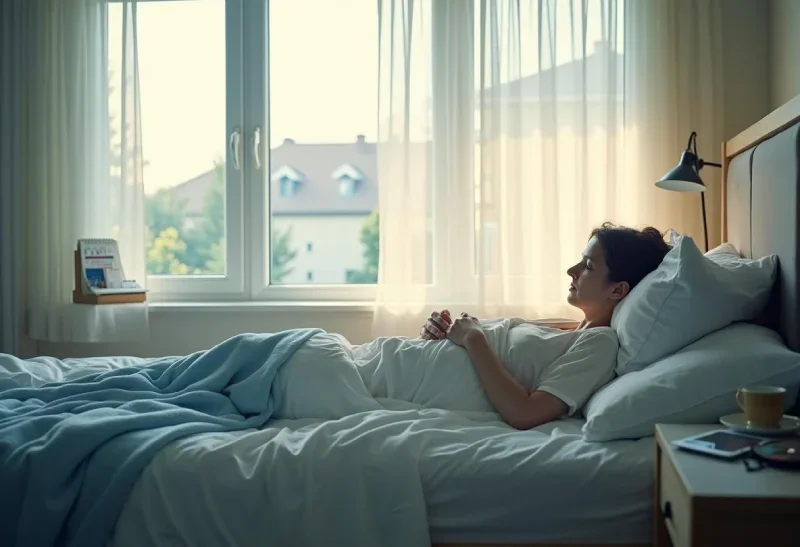What is the Age Limit for Tubal Reversal in Burleson, TX
Categories:
By: Ethan Cole
While there’s no hard-and-fast age limit for tubal reversal in Burleson, TX, real-world success data show that fertility declines steadily as birthdays accumulate. In plain English, healthy women under 35 generally see the highest pregnancy rates; however, motivated patients in their late thirties or early forties can—and do—welcome babies after tubal ligation reversal surgery every single year.
Below, we dive into the biology, testing, timeline, and financial planning you need to weigh before booking an operating-room date with Dr. Jason Neef or any other board-certified reproductive microsurgeon in the Metroplex.
Key Takeaways
No legal age cap exists, but Burleson tubal-reversal clinics weigh ovarian reserve, overall health, and remaining tube length—not just the date on your driver’s license.
Success rates taper after 35; the most significant drop happens past age 40, yet a robust egg supply and ≥4 cm of healthy fallopian tube can keep live-birth odds above 25 %.
Baseline fertility labs (AMH, FSH, estradiol) plus an HSG or HyCoSy give the clearest picture of whether tubal reversal, IVF, or donor-egg IVF will deliver the fastest path to parenthood.
Lifestyle upgrades—healthy BMI, balanced thyroid, smoke-free living—boost outcomes for every age bracket, often raising pregnancy rates by 10-15 %.
Financing programs, medical credit cards, and bundling packages make reversal cost-competitive with a single IVF cycle in Texas, especially for patients under 40 who may conceive multiple times from one surgery.
A focused consultation with Dr. Neef in Burleson (virtual or in-office) remains the quickest way to get personalized odds, pricing, and next-step guidance.
Am I Too Old for Tubal Reversal After 40?
Turning 40 doesn’t automatically close the door on tubal reversal success. In Burleson, Dr. Jason Neef and other reproductive surgeons regularly evaluate women in their early 40s who still have viable egg supply and sufficient tubal length. While the overall odds of natural conception decline after age 38, many patients between 40 and 42 do become pregnant—especially when their ovarian reserve is healthy (AMH above 1.0, FSH under 10) and at least 4 cm of tube remains.
The main difference after 40 is timing. It often takes longer to conceive, and fertility medications or intrauterine insemination (IUI) may be recommended to maximize each cycle’s chances. For women over 43, outcomes decline further, but tubal reversal can still be part of the discussion if lab values and imaging suggest favorable conditions. Ultimately, Dr. Neef’s approach is to weigh biological markers alongside chronological age so that patients can make informed, personalized decisions.
Tubal Reversal Success Rates After 35, 38, and 40+
When it comes to tubal reversal outcomes, age groups show distinct differences in pregnancy and live-birth rates. National and local Burleson data suggest:
Ages 35–37: Women often see pregnancy rates around 55–60% within 12 months of surgery. Live-birth rates average near 50%, provided at least 4–5 cm of tube remain and ovarian reserve markers are strong.
Age 38: This year is often a turning point. Success rates dip to about 40–45% for pregnancy and 34–38% for live births. Tube health and sperm quality become critical variables.
Ages 40–42: Pregnancy chances drop further, averaging 20–30% with live-birth rates around 15–22%. However, women with excellent ovarian function and sufficient tube length still bring home babies each year.
By the mid-40s, chances with your own eggs become very low, and IVF with donor eggs usually offers a higher success rate. Still, many women in their late 30s or early 40s choose reversal because one surgery can allow for multiple natural pregnancies, whereas IVF requires a new cycle for each attempt.
How Age and Biology Intersect in Tubal Reversal
Why Age Matters—but Isn’t Everything
“Chronological age” is simply your birthday math. “Biological age,” however, describes the current health of your ovaries, endometrium, and fallopian tubes.
Egg quantity (ovarian reserve) falls gradually after 30, then faster after 37, while egg quality—and thus embryo quality—also slide. This is why women often search for answers to questions like “Am I too old for tubal reversal at 38?” or “Can tubal reversal work after 40?”—because outcomes shift meaningfully around these milestones.
In parallel, tubal tissue must be long enough and flexible enough for sperm to reach the egg. Women whose original tubal ligation used a clip or ring usually retain more tube than those who had extensive cautery, making reconstruction easier even if they’re pushing 40.
Average Tubal-Reversal Success Rates by Age (Including 35, 38, and 40+ Benchmarks)
|
Age Range |
12-Month Pregnancy Rate |
Live-Birth Rate |
Typical Tube Length After Ligation |
|
<30 |
70–80 % |
65–75 % |
5–7 cm, minimal scar tissue |
|
30–34 |
65–72 % |
60–68 % |
5 cm common |
|
35–37 |
55–60 % |
48–55 % |
4–5 cm, mild scarring |
|
38–40 |
40–45 % |
34–38 % |
4 cm, careful reconstruction needed |
|
41–44 |
20–30 % |
15–22 % |
3–4 cm, assisted meds sometimes |
|
45+ |
<10 % |
<5 % |
<3 cm, consider IVF with donor eggs |
These figures come from aggregated data provided by tubal-reversal specialists in Burleson, Fort Worth, and Dallas, including outcomes tracked by Dr. Jason Neef’s practice.
Eligibility Criteria Used by Burleson Tubal-Reversal Surgeons
Beyond the Calendar: Medical Green Lights
Ovarian Reserve – An AMH above 1.0 ng/mL, FSH under 10 mIU/mL, and antral follicle count ≥8 signal solid egg supply.
Semen Analysis – Male factor contributes to 40 % of infertility; verify normal count, motility, and morphology.
BMI Range – Most surgeons prefer a BMI below 32; obesity can triple post-op complications and miscarriage risk.
Health History – Controlled blood pressure, balanced thyroid, non-diabetic glucose levels, and no unaddressed endometriosis enhance healing and implantation.
The Two-Step Consultation Process
Step 1: Telehealth or in-office review of your tubal ligation operative report, menstrual history, and partner’s reproductive background.
Step 2: Imaging (HSG or saline sono) plus bloodwork. Based on your metrics, Dr. Neef provides a personalized success estimate rather than a generic national average.
Realistic Expectations: Time to Pregnancy & Live-Birth Odds
Local tracking from Texas fertility centers shows median time to pregnancy of eight months for women under 35 and about fourteen months for women 38–40. Live-birth rates mirror the table above, but clinicians reiterate three dominant variables:
Residual Tube Length – Each extra centimeter can raise pregnancy odds by 5–7 %.
Sperm Quality – Normal motility and morphology reduce early miscarriage.
Uterine Environment – A healthy endometrium is critical after age-related egg factors are addressed.
Lifestyle Levers That Move the Needle
Quit Smoking – Nicotine constricts uterine blood flow; stopping three months pre-op boosts implantation.
Mediterranean Diet – Olive oil, leafy greens, legumes, and fatty fish supply antioxidants that improve oocyte health by up to 12 %.
150 Minutes of Cardio Weekly – Moderate exercise enhances insulin sensitivity and lowers inflammation markers tied to implantation failure.
Supplement Smartly – CoQ10 (200 mg), myo-inositol, and 800 mcg folate may improve egg quality, especially for women 35+.
Mental Wellness – Chronic stress elevates cortisol, which can impair ovulation; mindfulness or therapy can indirectly raise pregnancy rates.
Alternative Fertility Routes for Older Candidates
IVF in Burleson as a Companion or Backup Plan
IVF bypasses the tubes, helpful when tube length is compromised or AMH is <0.7.
Cost per IVF Cycle: $11,000–$15,000 before meds in North Texas.
Success with Own Eggs (40-42): 15–25 % per transfer.
Success with Donor Eggs (40+): 50–60 % per transfer—often the quickest route to take-home baby when biological clock is ticking loudly.
Adoption, Embryo Donation, and Foster-to-Adopt
Burleson social-service agencies and private adoption attorneys can fast-track family-building for couples who prefer a guaranteed timeline over medical uncertainty. Embryo adoption offers the chance to carry a pregnancy without the genetic constraint of diminished egg quality.
Preparing for Tubal Reversal at Any Age
Pre-Operative Checklist
Obtain your original tubal ligation report.
Begin prenatal vitamins plus DHA at least 90 days before surgery.
Manage chronic conditions (thyroid, hypertension, PCOS).
Schedule your procedure 2–3 cycles after a normal period to align early recovery with favorable hormonal timing.
Post-Op Recovery & Fertility Tracking
Expect light activity only for the first week; heavy lifting waits three weeks.
A follow-up HSG at three months confirms patency.
Use ovulation predictor kits or a wearable temp sensor to pinpoint fertile days; roughly half of pregnancies happen within six menstrual cycles for women under 35.
The Cost Equation in Burleson
|
Expense Item |
Typical Range |
Notes |
|
Surgeon’s Fee |
$4,800–$6,500 |
Microsurgical reversal with Dr. Neef |
|
Facility & Anesthesia |
$1,200–$2,500 |
Varies by hospital vs. surgery center |
|
Pre-Op Testing |
$300–$600 |
AMH, FSH, estradiol, HSG |
|
Total Out-of-Pocket |
$6,300–$9,600 |
Comparable to one IVF cycle |
Financing partners like CareCredit, Prosper, and CapexMD spread payments over 12–60 months, often with 0 % promotional APR windows.
Bottom Line
Age influences but does not single-handedly decide tubal-reversal success in Burleson. For women under 35, live-birth odds hover near 70 %. Healthy patients 38–40 can still hit 35 %, and select women 41–44 who harbor at least 4 cm of viable tube continue to bring home healthy infants. The decisive variables remain ovarian reserve, tube length, and the lifestyle choices you control. Book a consult with Dr. Jason Neef or another fellowship-trained microsurgeon, review your lab values, and weigh reversal versus IVF with clear, personalized data. Armed with that clarity, you can make the confident, timely decision that brings your future family into focus.
Book Your Tubal Reversal Consult with Dr. Neef Today
Call (817) 568-8731Categories:
Frequently Asked Questions
-
Tubal reversal is the lay term; tubal reanastomosis is the surgical description of reconnecting two healthy ends of a previously ligated fallopian tube. Both phrases describe the same outpatient microsurgical procedure that restores a natural path for sperm and egg to meet.
-
Dr. Neef typically uses a mini-laparotomy incision about two inches long, positioned low on the bikini line. Many patients report that the healed scar looks similar to a small C-section line and is easily concealed by underwear or swimwear within six months.
-
Not necessarily. Many women in their early 40s still achieve pregnancy after tubal reversal if they have adequate ovarian reserve and at least 4 cm of healthy fallopian tube. Success rates drop compared to women under 35, but Dr. Neef often sees natural pregnancies in motivated patients 38–42.
-
At 38, many women still have live-birth rates around 30–35% after reversal if tubes are long enough and egg supply is strong. Lifestyle changes and fertility medications can further improve outcomes.
-
Most office workers return in seven to ten days. Jobs requiring heavy lifting or prolonged standing may need a two-week break. Always follow your surgeon’s postoperative guidelines, as individual healing speed varies.
-
Yes. Reconnecting the tube carries a 5–8 % ectopic pregnancy risk, compared with about 1–2 % in the general population. Early ultrasound at six weeks gestation is recommended to confirm implantation in the uterus.
-
Pregnancy chances after 45 are very low (<5%). In most cases, IVF with donor eggs provides a higher success rate. However, Dr. Neef will evaluate tube length, egg supply, and overall health before giving a personalized recommendation.
-
Most medical lenders assess credit score and income, not age. Some require proof of employment or assets. Patients over 45 might face stricter underwriting, but co-signers or joint applications often resolve financing hurdles.
-
A handful of self-funded employer plans and military insurance options have reimbursed portions of tubal reversal when medically justified. Always submit a pre-authorization request with operative notes and physician letters to maximize any chance of partial coverage.
-
Yes. One advantage over IVF is that tubal reversal lets you conceive naturally multiple times without paying for additional cycles. As long as your ovarian reserve remains adequate and no new pelvic issues arise, future pregnancies are possible until menopause.













